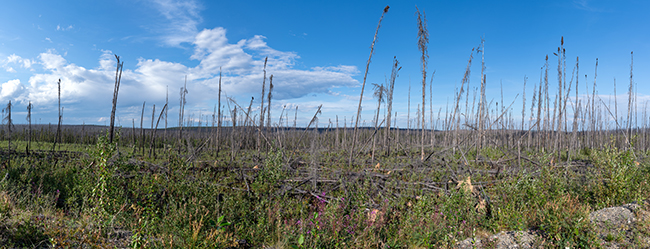New report provides a review of the current scientific literature on climate impacts in northern forests.
Forests, particularly tropical rainforests, are often called “the lungs of the Earth” due to their vital role in our climate system: taking in and storing carbon dioxide and producing oxygen.
To date, far less attention has been paid to their northern cousins: the boreal and temperate forests that stretch across the north of Asia, North America and Europe. But northern forests play just as critical a part in our climate system and for climate mitigation.Northern forests hold around 54% of the world’s total terrestrial carbon stock and contribute more than one-third to our global terrestrial carbon sink. The boreal biome alone is the second largest terrestrial biome of the world.
High intensity wood harvesting is currently the biggest threat to northern forests. Forests with reduced resilience due to decades of logging activities are now facing further harms aggravated by climate change. These intersecting impacts threaten to turn certain ecosystems from carbon sinks into sources. In contrast, untouched primary forests have been found to be less affected by climate impacts.
Temperatures are rising much faster in northern forest regions than the global average. In some of these regions, the temperature increase has been more than double the global average.
The fingerprints of climate change can already be found across these ecosystems. Reduced snow cover, increases in extreme precipitation and drought, and extreme heat events make it difficult for these complex forest ecosystems to maintain their integrity.
This report provides a review of the current scientific literature on climate impacts in northern forests. It is clear that:
Northern forests are already being threatened by climate change at 1.2°C of warming. Further warming will only exacerbate climate impacts and pose an existential threat to northern forest biomes.
Beyond 1.5°C of warming – the limit enshrined in the Paris Agreement – we risk triggering tipping points and regime shifts. These could become widespread around 3.5°C which would irrevocably degrade and even destroy boreal and temperate forests.
In boreal forests, drought has already led to increased tree mortality in the last two decades. Globally, 30% of tree species are currently at risk of extinction due to different factors. Increased drought impacts from climate change could contribute to the extinction of boreal tree species.
The frequency and extent of forest fires have been higher in recent years than at any time in the last 10,000 years. More frequent and severe fires are contributing to post-fire recovery failure, increased carbon emissions, decreased carbon sink potential and incomplete re-sequestration of carbon in the subsequent growing seasons. Boreal forest fires release 10 to 20 times the carbon emissions per unit of area burned compared to grassland ecosystems.
Insect outbreaks have been increasing in severity, range, and duration in the past few decades. Warmer climates, longer growing seasons, weakened tree defences following drought or wildfire occurrences support insect development and reduce pest mortality. Acute outbreaks have been recorded across the northern forest regions and have led to large-scale tree mortality events. From bark beetle outbreaks alone, around 14.5 million cubic metres of European forests have been damaged every year from 2000 to 2010. Highly homogenous forests are at higher risks of insect outbreaks and damages, making plantations or managed forests more vulnerable than old-growth forests.
As temperatures rise, northern forests are expanding northward into new territories, and are experiencing dieback events along their southern-most borders. However, warming impacts are outpacing forest advance, threatening any carbon sequestration potential of the northwards expansion.
Crossing tipping points within boreal forests will have consequences for the global climate. Both the northward expansion and the southward contraction of forests change the Earth’s land surface albedo (how the Earth’s surface reflects or absorbs light from the sun) but ultimately the combined effect diminishes the important function of these forests as carbon sinks. This could lead to northern forests becoming a considerable carbon source.
Given the important ecosystem services that northern forests provide and their role as an integral carbon sink in efforts to limit warming to 1.5°C, northern forests warrant urgent and effective forest conservation. Forest clearing from human activities remains the number one threat to these precious ecosystems. With the scale and severity of the climate impacts that these forests are facing today, more needs to be done to adapt our forestry and conservation practices to ensure these forests do not experience irrevocable harm. When developing restorative and regenerative forestry practices, much can be learned from indigenous knowledge.
The forests best-equipped to withstand climate impacts are those with high structural diversity – such as old-growth stands. These old stands also deliver enhanced multifunctionality and provide the most ecosystem services. While trade-offs between ecosystem service provision will have to be made, the conservation of the remaining old-growth forests should be made a priority.
The authours are researchers at Climate Analytics.
Link to report: https://climateanalytics.org/publications/climate-impacts-in-northern-fo...























